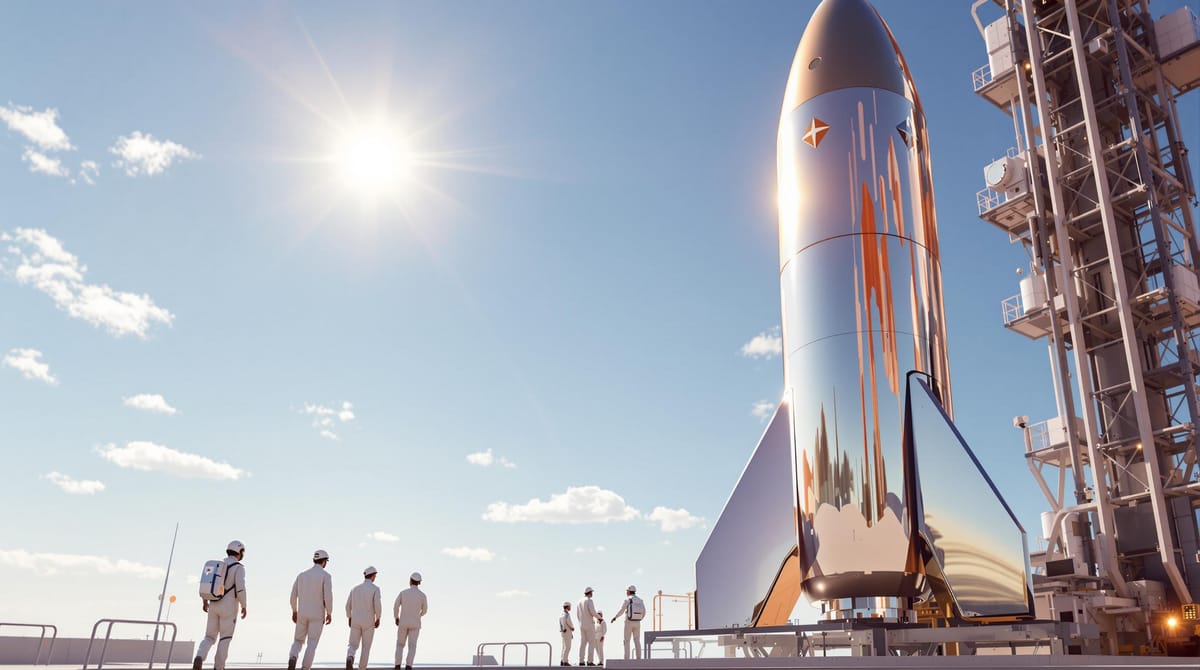Why SpaceX Uses Stainless Steel for Starship
Explore why stainless steel is the ideal choice for innovative spacecraft, balancing cost, durability, and extreme temperature resistance.

SpaceX chose stainless steel for Starship because it’s strong, affordable, and handles extreme temperatures better than other materials. Here’s why it works:
- Cost: Stainless steel costs about $3 per kilogram, much cheaper than carbon fiber or titanium.
- Heat Resistance: It withstands temperatures up to 1,600°F, ideal for reentry without heavy heat shields.
- Durability: It gets stronger in cold temperatures and resists corrosion, perfect for space and cryogenic fuel storage.
- Ease of Production: Stainless steel is easier to weld and shape, speeding up manufacturing and repairs.
This combination of strength, affordability, and versatility makes stainless steel the best choice for a reusable, mass-produced spacecraft like Starship.
Why SpaceX Chose Stainless Steel for Starship!

Limitations of Common Aerospace Materials
Standard aerospace materials are effective for smaller vehicles but fall short when scaled up for Starship. The main challenges lie in cost, heat resistance, and long-term durability, as explained below.
High Material Costs
Materials like carbon fiber composites and titanium offer excellent strength but become extremely expensive when used at Starship's scale. Their complex manufacturing processes and limited supply make them unsuitable for a spacecraft intended for mass production.
Heat Resistance Challenges
Starship must endure extreme conditions - from the intense heat of reentry to storing cryogenic fuels. Most traditional aerospace materials perform well within specific temperature ranges but cannot handle the wide thermal demands Starship requires.
Durability Over Time
Frequent reuse of Starship demands materials that can handle repeated thermal cycling, UV radiation, and the stresses of reentry. Conventional materials degrade over time and require significant maintenance, making them impractical for quick turnaround. This is why stainless steel, with its ability to meet these challenges, is a better fit for Starship's unique needs.
Stainless Steel Benefits for Starship
Stainless steel offers several key advantages for Starship, directly improving its performance and efficiency.
Lower Production Costs
At roughly $3 per kilogram [1], stainless steel is far cheaper than traditional aerospace materials. This affordability helps SpaceX allocate resources efficiently, supporting rapid development and frequent design iterations.
Strength in Extreme Conditions
Stainless steel becomes stronger in extremely cold temperatures, making it perfect for storing cryogenic fuels and withstanding the harsh conditions of space. Its natural resistance to corrosion means no additional protective coatings are needed, enhancing its durability.
Exceptional Heat Tolerance
With the ability to endure temperatures up to 1,600°F (870°C) [1], stainless steel handles the intense heat of atmospheric reentry without requiring heavy heat shields. This capability ensures safe operations across a wide temperature range, all while keeping the spacecraft's weight in check.
Stainless Steel Design Features in Starship
Managing Heat with Reflection
Starship's stainless steel exterior plays a crucial role in handling extreme heat during reentry. Its polished surface reflects much of the intense heat, helping to regulate the spacecraft's temperature. This reflective property reduces the need for additional heat protection in certain areas, making it a practical choice for thermal control.
Advanced Cooling System
Beyond its reflective surface, Starship includes an active cooling system tailored for the most heat-intensive areas during reentry. This combination of passive reflection and active cooling ensures the spacecraft stays within safe temperature limits during critical moments of flight.
Material Performance Analysis
SpaceX chose stainless steel for Starship due to its superior performance under extreme conditions, especially compared to traditional aerospace materials like carbon fiber. While carbon fiber offers a good strength-to-weight ratio, it struggles to withstand the intense heat of reentry. Stainless steel, on the other hand, excels in these critical moments.
This material holds up under the high temperatures of reentry and can also handle the cryogenic conditions needed for storing propellants. Its ability to perform reliably across such a wide temperature range ensures consistent functionality throughout the entire flight. Additionally, streamlined production methods further enhance its practicality.
Stainless steel is also more affordable and easier to work with than carbon fiber. Unlike carbon fiber, which requires intricate manufacturing processes and strict quality control, stainless steel can be shaped and assembled using conventional welding and forming techniques. This reduces both production time and costs. Its durability also allows for straightforward repairs and on-site maintenance, aligning perfectly with Starship's goals for quick reusability and long-term efficiency.
Conclusion: Impact of Steel on Starship Design
SpaceX's decision to use stainless steel allows for a more affordable and reusable spacecraft. The material's natural characteristics help simplify the design and reduce maintenance needs.
Key features like its thermal performance make managing heat easier, while its flexibility supports quicker prototyping and simpler repairs. These qualities highlight why stainless steel plays a key role in improving durability and efficiency in space travel.
Comments ()